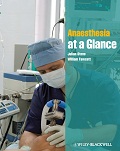- Home
- Multiple Choice
- Cases
- Your feedback
- Become a reviewer
- ‘At a Glance’ series
- Wiley student books
- Student Apps
- Join an e-mail list


You are called to the delivery suite for a 39-year-old woman (gravida 5) who has a retained placenta and a post partum haemorrhage. She requires manual removal of the placenta. She has not clinically shocked but the estimated blood loss is 1000 mL. She is otherwise well.
1. What are the advantages and disadvantages of regional anaesthesia?
2. What are the advantages and disadvantages of general anaesthesia? Advantages: quick and reliable. Disadvantages: GAs have greater morbidity and mortality associated with them. Tracheal intubation is much more difficult in obstetrics patients.
3. The patient has been fasted for 12 hours: does she need tracheal intubation?
4. The patient loses another 500 mL of blood rapidly and requires immediate blood transfusion. If there is no cross-matched blood available, what would you do?
5. Attempted manual removal under a spinal anaesthetic fails as the placenta remains adherent and blood loss continues. The surgeons wish to perform a laparotomy and possible hysterectomy. How would you manage the patient?